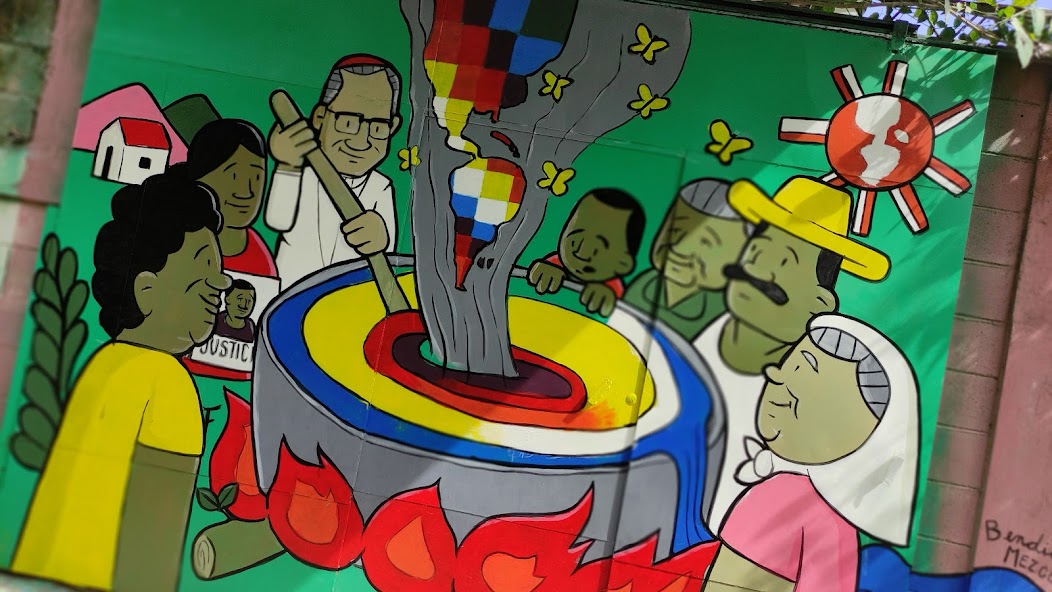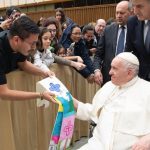
Oscar Romero Murals
On the feast day of St. Oscar Romero, we want to celebrate those who have accepted the mission of listening to the cry of the poor in our world: “It is not God’s will that some have everything and others have nothing […] It is God’s will that all his children be happy,” said Monsignor Romero in 1978.
The Aguapanelazo missionary group was born 9 years ago, during the Year of Mercy, as an initiative of the youth ministry of Ibagué, Colombia. It travels throughout Latin America bringing drink, bread and art to the most vulnerable communities. St. Oscar Romero has been one of its great references and role models.
In dialogue with Colombian Consolata missionary and project founder Jonathan Acuña, we share the organization’s history and how it is linked to Laudato Si’. “Aguapanelazo” comes from “agua de panela”, a sugar-based drink common in the Colombian region.
Following St. Romero’s example
Speaking about St. Romero, Jonathan says: “His powerful words and courageous witness have inspired us to work in the diverse realities of need, pain and suffering, always seeking to be God’s liberating and consoling presence among the most excluded members of society. They are, as Romero said, ‘Christs in need who are at our very doors.'”
Forty-three years after his martyrdom, Oscar Romero “continues to challenge us,” Jonathan affirms. “His contribution to the path of humanization, justice and peace in El Salvador and around the world motivates us to be artisans of the construction of another possible world, of the Kingdom of God that is unfolding today and that needs women and men who, being critical of reality, are capable of going against the current to be active agents of transformation, striving with hope and courage, even to the point of death, as he did.”
Following the example of San Romero, the Aguapanelazo mission seeks to reach out to those who live on “the existential frontiers of our world”: Afro-descendants, indigenous people, peasants, victims of armed conflict, migrants, displaced people, street dwellers, children and young people in vulnerable situations. South America concentrates different realities; the presence of all these marginalized communities has allowed the mission to adapt and respond to very diverse problems.
How does Laudato Si’ relate to this mission?
Many members of Aguapanelazo met through Laudato Si’ Movement activities. Thanks to the Animators Program, in which all members are invited to participate, they are trained in an ecological sense. Likewise, Laudato Si’ Week and the Season of Creation are key moments for them, and they participate by organizing events.
They consider it fundamental to care for the Common Home and to live an integral ecology. “In our pillars of mission and consolation, we want to listen to the cry of the poor and of creation. For the work for justice must be for an integral justice, which ensures that all people have a home in which to develop,” says Jonathan. Among his missions are cleaning brigades and the planting of endemic plants such as the wax palm, an icon of Colombia.
Listening to and representing the community
In 2021, the ‘Murals for Peace: Theo-artistic Mission’ project was launched to continue listening to “the cry of the poor”. The aim of the project is to listen to the community, represent its people and show Christ in their midst. A total of 50 murals have been painted in Colombia, Argentina, Venezuela, El Salvador and also in Italy.
Argentine Cristian Camargo, one of the artists behind the murals, tells us: “In 2021, during a Laudato Si’ Movement encounter, I met Jonathan. We were moved by the context of war, and we talked about a peace proposal. We agreed on this crazy dream of doing an artistic mission in Latin America using the murals as a pretext to unite the community by promoting fraternity and social friendship”.
Thanks to a trip to Italy with his congregation, Jonathan was able to present Pope Francis with two gifts on behalf of Murals for Peace and the Laudato Si’ Movement: the painting “The Church with an Amazonian Face” by Juan Camilo Herrera and a stole painted by Cristian Camargo.
It is reported that in Colombia there are more than 70,000 displaced Indigenous People and the call of Pope Francis in “Querida Amazonia” and “Laudato Si'” has inspired missionaries to reach out to the Colombian Amazon and other displaced communities.
Thanks to Colombia’s Amazonian territory, the mission naturally accompanies the Indigenous Peoples and nature, as well as the Afro communities that have been left behind on some beaches. The Aguapanelazo mission is encouraged and accompanied by Archbishop Luis José Rueda, Archbishop of Bogota and president of the Colombian Episcopal Conference.








